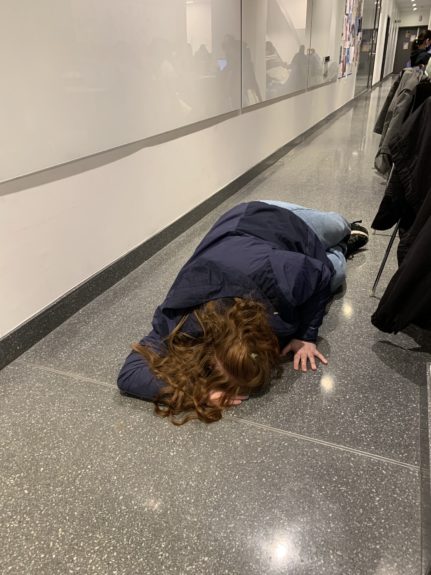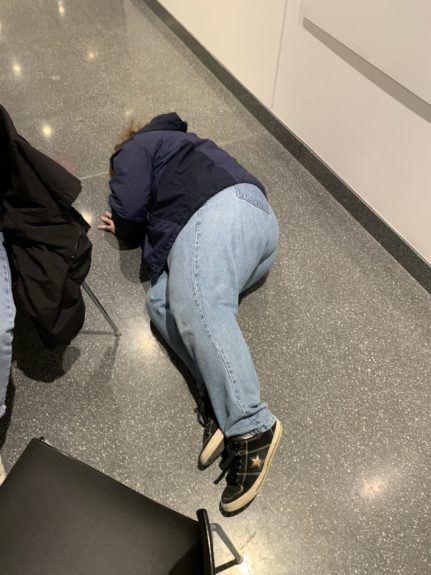This week, Bwog sat down with Epiphany Larmey and Delaney Wellington, the Barnard juniors behind the Instagram account @whatisweecha. We learned about a campus-wide conspiracy, a statue of lies, and the greatest pursuit of truth this college has ever seen. Aditi Misra and Eliza Staples have the story.
Anyone who has been on Barnard’s campus in the past semester has seen the newest installment: Weecha. Located outside the Diana Center, a blue and white geometric spiral disrupts the terracotta and gray harmony of Barnard’s campus. No one is quite sure where it came from, or what purpose it serves. Two students, Epiphany Larmey and Delaney Wellington, created the Instagram account @whatisweecha to learn the truth about this mysterious apparition and the institution’s true purpose of bringing it into our lives.
When asked why they first started the account, Epiphany responded that it provided a space to present their findings of Weecha, and promote curiosity in the Barnard community. With such inquisitive and intellectually-minded goals, President Sian Beilock herself would certainly support this endeavor, particularly in Barnard’s Year of Science. However, the interviewers soon realized that much darker forces were at play. Delaney described an early encounter with the alleged “statue”: “Weecha called to me one day last semester… I don’t know how I could describe this other than energy.” We pressed her for a more specific description, but the answer was not suitable for our readers’ delicate sensibilities. Delaney explained that she only started feeling this energy on the day that Weecha arrived, and that the energy would get stronger as one drew nearer to it. She realized that her fellow students felt similarly, and she and Epiphany endeavored to learn all they could about the supernatural phenomenon in our midst.
With the staggering success of the @whatisweecha account (over 150 followers), it’s only natural to ask what content they will be sharing next. In true Barnard spirit, Delaney and Epiphany plan to continue their inquiry for truth. Epiphany noted a series of developments that occurred this weekend, which “completely altered the direction and the momentum of the investigation.” Followers can expect to see this information by the end of the week, as Delaney and Epiphany work out the legalities of sharing their findings. “It will blow your mind—my mind, again, when I see it,” Delaney professed. They have no plans to stop their work. “We see it as a full-fledged investigation,” Epiphany shared. “It’s infiltrated our lives.” As they put it, they plan to find out “not just what Weecha is or who Weecha is, but the nefarious schemes of this institution” in which, they claim, Weecha plays a central role.
On the topic of nefarious schemes, we inquired after the anonymous Barnard student who hasn’t seen their family since the arrival of Weecha to this campus, which marked the beginning of Barnard’s Year of Science. “We are still on a journey to figure out what Year of Science really means,” Delaney explained. At this point, both Delaney and Epiphany broke into tears, distraught over the student’s chilling testimony. They shared that they want the student to know that their hearts go out to them and that they want to answer the questions on the student’s mind. “We believe you,” they stated. “We believe that it’s Weecha… that power is enough to make a family disappear.” Delaney expanded on this, saying, “Humans are unjustly used for science in the past and unfortunately, also in the present.”
Of course, Delaney’s statement naturally brought up the question: are we as Barnard students subjects of an experiment? Both interviewees sighed despondently as if they had just been hexed. Epiphany admitted that yes, that is their suspicion, but that they didn’t want to spread fear without full knowledge of the forces at play. “We are scared,” Delaney bravely shared. “It’s important that we use this fear as a force for good, for ethical investigation and finding answers.” Epiphany nodded in agreement, adding, “We believe that the truth is more important than any source of fear.”
The investigators hope to use the @whatisweecha platform to share the truth with a wider audience, but with this objective comes risk from those in power. The pair had already received some threats, one of which was shared on their Instagram account, leading to their investment in burner phones for personal protection. Epiphany even shared that faculty members now look at her differently given her involvement in the investigation. She wishes these people in power to be aware that they “only have every Barnard student’s interest and safety at heart. We are simply the mouthpiece for the Barnard community, and we are not afraid. Whatever they are doing, we know that Weecha is central to it.”
This emphasis on community is central to @whatisweecha’s goal to circulate the truth. Delaney and Epiphany have already begun to hear stories from students who feel safe enough to come forward, and hope that the more this happens, the more information can come to light on the truth behind Weecha. There is a fervent belief among the pair that this investigation runs deeper than it appears, and they call on the student body to “tell us your story, use this space to find community amongst yourselves, and be vigilant.”
Bwog asked the pair what their current answer to their username’s question was based on their findings thus far. Upon asking this question, Delaney stared into the distance in deep thought, perhaps remembering the might of Weecha. Epiphany described the sculpture—believed to be more than that—as a “force” and symbol of instability. Delaney, once out of the Weecha haze, revealed that the pair had an enlightening conversation with the sculptor of Weecha (which will be revealed on their Instagram soon). She mentioned that Henry Richardson used she/her pronouns to describe the statue and claimed it (or she, as Henry would say) was named after his professor, but then “doubled back on this saying he misspoke.” He claimed he needed media training in order to participate in the interview, which confused the pair given that Weecha is a statue. Once Delaney and Epiphany continued to push back in the conversation to find some answers, he became audibly nervous and began to stutter. The interview ended in a confession that will be posted on the Instagram account soon, once legalities are sorted out and Henry’s safety is ensured.
When they were asked what other campus mysteries they hope to expose, both interviewees had to take a moment to breathe. Delaney became so overwhelmed by the thought that she fell to the ground, which she informed us has been a common occurrence since the investigation began. After Epiphany instructed her to box breathe and affirmed that they were “doing the right thing,” Delaney stated that while it is a dark world out there, “it’s getting lighter every day.” @whatisweecha is trying to bring that light back.

Delaney falls to the ground upon the thought of other mysteries that exist within the boundaries of Barnard College. 
Delaney shortly before box breathing and, in turn, finding optimism within the darkness.
Barnard Year of Cover-ups via Epiphany Larmey
Photos via Aditi Misra


 0 Comments
0 Comments